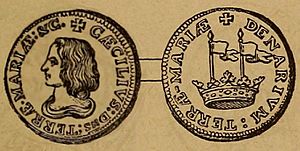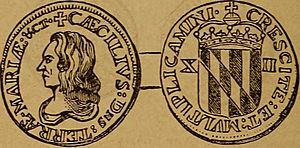Lord Baltimore penny facts for kids
| Years of minting | 1659 |
|---|---|
| Obverse | |
 |
|
| Reverse | |
The Lord Baltimore penny was the first copper coin ever used in America. It was part of a special set of coins, including three silver ones, made just for Cecil Calvert, 2nd Baron Baltimore, who was a powerful leader. These coins were meant to be used in the Province of Maryland, one of the original Thirteen Colonies in America.
Contents
History of the Lord Baltimore Penny
The Lord Baltimore penny is one of four special coins made for Cecil Calvert, also known as "Lord Baltimore." These coins were designed for use in the Maryland colony. This copper penny was the very first copper coin to be used in the American Thirteen Colonies.
Designing the Coins
The person who designed the special coin molds for Lord Baltimore was Nicholas Briot. On October 12, 1659, Briot sent samples of the new coins from London. These samples went to Philip Calvert, who was Lord Baltimore's brother and the secretary for Maryland.
The samples included a shilling, sixpence, groat, and the copper penny. Briot suggested that these coins could be made in London and then sold to the Maryland colonists. Lord Baltimore then presented this idea to the colonists to see if they would officially use the new money.
A Mint for Maryland?
Philip Calvert became the governor of Maryland in November 1660. He pushed for the idea of creating a mint, a place where coins are made, right there in the colony. On May 1, 1661, the Maryland Assembly passed a law to set up a mint. This law even described exactly what coins would be made and how much they would be worth compared to English money.
However, an official Maryland mint was never built. An English council decided that creating their own mint was beyond the rights given to Maryland in its original charter. So, the idea of a colonial mint was dropped. Even so, Lord Baltimore had many silver coins made for him in London and shipped them to the colonists. He was paid for these coins with tobacco. We don't know how many of these silver coins were actually used in Maryland.
The Rarity of the Copper Penny
The copper Lord Baltimore penny is extremely rare today. Only two of these coins are known to still exist!
The First Penny Found
The first Lord Baltimore penny was discovered in England in 1819. It was first mentioned when it was sold to William Dinedale from a coin collection owned by James Bindley. This collection was later sold in 1824 to Rev. Joseph Martin in England.
The coin then passed through several hands. It was bought by William Webster in 1859 and later by Joseph J. Mickley from Philadelphia. Mickley's Lord Baltimore copper penny was sold in 1867 for US $370. It eventually became part of the collection of Charles I. Bushmell, a New York coin collector. Bushmell's collection was sold in 1890 for US $550 to Mr. Bock, a Philadelphia collector. Bock later gave his entire coin collection to the University of Pennsylvania.
The Second Penny Found
The second Lord Baltimore copper penny was found by B.H. Collins, a well-known coin collector from Washington D.C. He found it in a pile of old, worn copper coins. This second penny was also bought by Mr. Bock. It came with a set of English silver coins made for Lord Baltimore: a shilling, a sixpence, and a groat.
Lord Baltimore Coin Designs
The Lord Baltimore coin set included four coins: three made of silver and one made of copper.
Front Side (Obverse)
On the front side, called the obverse, of all the coins, there is a picture of Lord Baltimore's head looking to the left. These 1659 coins were made in England to test if they would be used in the colonies. Around Lord Baltimore's image on the front of these coins, there is writing that says "Caecilius, Dns: Terrae-Mariae." This means "Cecil Lord of Mary's Land."
Back Side (Reverse) of Silver Coins
On the back side, or reverse, of the silver coins, there is a shield called an escutcheon with the Baltimore family's coat of arms. This shield has a special crown, called a coronet, on top.
- The Lord Baltimore shilling silver coin has the Roman numerals "XII" (which means 12) on the right and left sides.
- The sixpence silver coin has "VI" (meaning 6).
- The groat silver coin has a "IV" (meaning 4) to show it was worth fourpence.
The shilling was made of 92.5% pure silver and weighed about 66 grains. The Maryland sixpence silver coin was the same quality and weighed about 34 grains. Both the shilling and sixpence were a little less than an inch across. The Maryland groat silver coin came in two types, one with a small picture and shield, and another with a larger one. It weighed about 25 grains and was about half an inch across.
Back Side (Reverse) of the Copper Penny
The Lord Baltimore penny copper coin was similar to the silver coins, but its back side was different. The reverse side of the copper penny shows a duke's coronet crown with two pennons (small flags) flying in the center. Around this image, the writing says "Denarium Terrae-Mariae," which means "Denarius of Mary’s land." The penny is about 13/16ths of an inch across. This size is between the Lord Baltimore groat and sixpence coins. It weighs about 57.5 grains.


